The 5 Layers Of Earth’s Atmosphere – What They Are And Their Characteristics
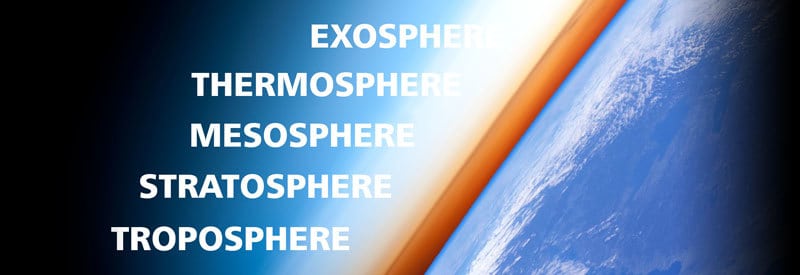
If you look up on a cloud-free day, you will observe what seems to be a blue sky, spanning from horizon to horizon. Earth's atmosphere, though, consists of five distinct layers, each with its own features.
The 5 Layers Of The Atmosphere

The Space Shuttle With The Different Atmospheric Layers In The Background.
- Troposphere
- Stratosphere
- Mesosphere
- Thermosphere
- Exosphere
In this article, we take a closer look at each of the five layers, their composition and characteristics, as well as their importance and the role they play in protecting the planet.
To provide a global picture and avoid confusion, the diagram of the atmosphere with all five layers below will help you to orientate yourself at any time.
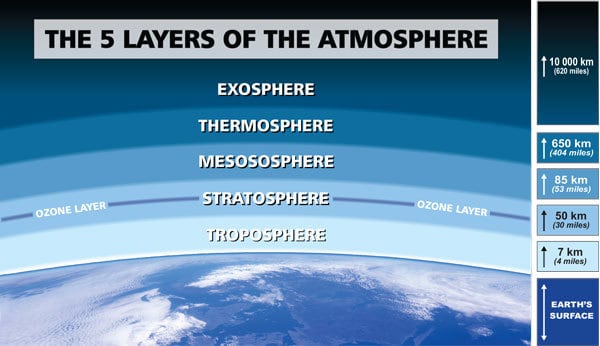
Diagram Of The Atmosphere And Its 5 Layers
The Troposphere
The troposphere is arguably the most important layer of all for us humans. This is the layer we all live in, and also the layer that supports all other forms of life as well. It is also the layer in which almost all forms of weather occur.

Composition Of The Troposphere
The air in the troposphere contains all the elements necessary for all forms of life to exist. It also contains the vast majority of water vapor on the planet. (More than all the other layers in the atmosphere combined.)
To be more get a better picture, let's take a closer look at the specific elements that make up the air in the troposphere:
- Nitrogen (78.08%)
- Oxygen (20.95%)
- Argon (0.93%)
- Carbon Dioxide (0.04%)
- A Variety Of Smaller Gasses
Every one of these elements plays an important role in creating an atmosphere conducive to supporting the existence and growth of life on earth. (And this includes carbon dioxide, which got a really bad reputation as a result of its role in global warming due to its rapid increase. It actually plays a vital role in the survival of plant life.)
As I already mentioned, the troposphere also contains more water vapor than all the other layers combined. To be more precise, 99% of all water vapor is concentrated in the troposphere.
The importance and advantages of water are too many to get into detail. It is a vital source of hydration for humans (our bodies consist of 60% water after all) and animal life. It is also essential for all forms of vegetation to grow and flourish.

Water also plays an important role in regulating temperatures around the world. This aspect of water is closely related to one of its most important functions, which is to form and regulate weather systems on a global scale. Without water, the occurrence of weather in any significant form will simply be impossible.
We should also never overlook the importance of the behavior of temperature & air pressure in the troposphere. Both show a steady decline as height above the earth's surface increases.
The Earth gets heated from the bottom up. The sun heats the earth's surface, where the highest temperatures can be found. It then starts cooling down as its height increases. The temperature keeps dropping and reaches temperatures as low as -55° Celsius (-64° Fahrenheit) at the troposphere's upper limit.
Similarly, the air pressure is at its highest at the surface of the planet, where the gravitational forces are at their strongest. As the particles in the air are pulled closer together, the air is much more dense as a result.
As the air increases in height, the gravitational forces become less, and the air density starts to drop. At the upper reaches of the troposphere, the air is so thin that breathing becomes almost impossible. (This is the reason why mountaineers scaling high mountains often need some form of breathing apparatus to breathe.)
Characteristics Of The Troposphere
Starting at the surface of the planet, the troposphere reaches an average height of around 7-12 km (4-7 miles). This height is not constant, though, and varies depending on your location on earth.
The troposphere is at its highest above the tropics (reaching heights of 20 km or 12 miles at the equator). Over the polar regions, it reaches its lowest point (as low as 7 km or 4 miles).
The height of the troposphere also varies from season to season as a result of the difference in temperature, which directly influences the troposphere. This is most obvious during the winter and summer months over the mid-latitudes.
During summer months, the warmer temperatures cause the air to expand, which causes an increase in the height of the troposphere. During the winter months, the colder temperatures cause the air to contract and make it more dense, causing the height of the troposphere to decrease as a result.
At the top of the troposphere, you will find a thin layer called the tropopause. This layer forms the boundary between the troposphere and the lowest part of the stratosphere.
Very often, you will see the top of a big storm cloud flattening out, giving it its familiar anvil shape. This due to the fact that the updrafts in the storm cloud bump into the tropopause & lower parts of the stratosphere where the air temperature is warmer than the air below it.
As, a result the cloud cannot expand any further in height, and starts expanding out horizontally at the border between the 2 layers.
Importance Of The Troposphere
We will all spend our entire existence on this planet in the troposphere. (Except, of course, if interplanetary travel and colonization become possible and viable within the next few centuries. Something I seriously doubt for some reason if I look at the rate of progress of space exploration attempts over the last half-century.)

And no, commercial pilots and astronauts don't count, as they literally spend a fraction of their lifetimes outside the troposphere. On top of that, that period of time is spent inside an artificially created environment that mimics that of the troposphere. In other words, technically, they are still in the troposphere.
The reason why the troposphere is so important is that it contains all the vital elements that make it possible for life on earth to exist. I already covered that in the previous section, but it's worth summarizing why it is so important.
The most 2 most important aspects of the troposphere that make life on earth possible are:
1) Necessary Gasses
I already mentioned the primary gasses the troposphere consists of. (Nitrogen, oxygen, argon, and carbon dioxide.) It also contains trace elements of neon, helium, methane, krypton, hydrogen, and off-course, water vapor.
All these gasses play an important part in keeping us alive. Oxygen allows us to breathe, and carbon dioxide is essential for plant life. All the other gasses have some role to play in the formation, protection, and preservation of so many forms of organic and inorganic objects, to mention just a few functions.
2) Weather
Weather is just as important for life to exist on earth. Naturally, it requires water vapor, of which 99% resides in the troposphere.
The advantages of weather should be obvious, but here are just a few examples:
Creates Seasons: This is important as seasons (winter, spring, summer, autumn) helps to regulate and balance the planet's temperature, rainfall, and air movement.
Provides Rainfall: This is not only important to keep human and animal life hydrated by keeping bodies of water full, but also moisturize the soil, which keeps vegetation (including crops in the agricultural sector) growing.
Creation Of Winds: This an often-overlooked advantage of the weather. First of all, winds are responsible for moving weather systems above the planet's surface. A second very important function of wind in our modern world is its "cleansing" effect. Strong winds are responsible for clearing away impurities that might have formed in the air above certain locations. This includes the volcanic cloud particles above a volcano, the dense fog at coastal regions, smoke, and smog that accumulates over urban areas.
As important and critical as the troposphere is, it cannot function on its own. It needs the other layers in the atmosphere to function properly. It is time to move on to the second layer of the atmosphere.
The Stratosphere
The stratosphere is situated just above the troposphere, only separated from it by a thin transitional layer called the tropopause, which contains a a mixture of both layers.
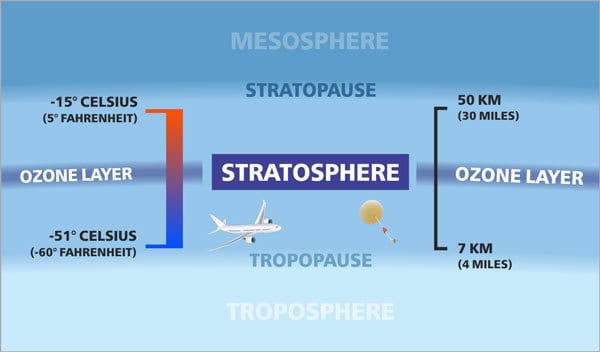
Composition Of The Stratosphere
The stratosphere contains very few of the elements found in the troposphere. The majority is broken down by sunlight or deposited back to the planet's surface via rain.
Temperature inversion takes place between the troposphere and stratosphere. (An increase in temperature with height.) This also contributes to making the exchange of air between the 2 layers virtually impossible.
By far the most important element present is ozone. The stratosphere contains the biggest concentration of ozone of all the layers.
Air is extremely dry in the stratosphere, as water contained in the air and clouds is trapped in the troposphere. (With almost no air exchange between the 2 layers, as already mentioned.) This means basically no form of precipitation takes place from the stratosphere.
The air continues to get less dense as height increases, leading to air in the stratosphere to be about a 1000 times thinner than at the sea level.
Characteristics Of The Stratosphere
The stratosphere starts at a height just above the troposphere and reaches as high as 50 km (30 miles) above the surface of the earth.
Almost no weather occurs in the stratosphere, although big storm clouds (in the form of supercells containing cumulonimbus clouds) occasionally punch through the tropopause and reaches lower parts of the stratosphere.

One of the main characteristics of the stratosphere is an occurrence called temperature inversion.
Temperature inversion occurs when the temperature rises as the height above the earth's surface increases. (This is the direct opposite of what occurs with the air temperature in the troposphere.)
Starting with an average temperature of -51° Celsius (-60° Fahrenheit) just above the troposphere, it starts to increases in temperature, reaching an average of -15° Celsius (5° Fahrenheit) close to the mesosphere.
One of the most important functions of the stratosphere, though, is the presence of the very important ozone layer within the stratosphere. This layer of ozone protects the earth from the harmful ultraviolet rays of the sun.
A very simple way of explaining how the ozone layer protects us is to see the ozone layer as a gigantic filter. It allows the less harmful longwave UVA radiation through while absorbing the more dangerous shortwave UVB & UVC radiation. This is done through a process called the "ozone-oxygen cycle."
The ozone layer gained fame and came to the forefront a few decades ago when a hole in the layer was discovered over the Antarctic. Through a process called ozone depletion, large amounts of ozone were reduced in the stratosphere.
It was mainly caused by CFC gasses, commonly used in refrigerators and air conditioners at the time. An international ban on the use of CFC gasses was issued, and since then, the ozone layer has made a significant recovery.
(On an interesting note, as necessary as the ozone layer is for protecting the Earth from the sun's harmful UV radiation, it is actually quite harmful to us humans. It is can cause a variety of respiratory problems and permanently damage your lungs when inhaled.)
Importance Of The Stratosphere
By far the most important attribute of the stratosphere is the fact that it contains the ozone layer that is so vital to all life on earth. (It has already been discussed and explained, so no need to explain its importance again.)
The state of the ozone layer is so important that weather balloons are send up on a regular basis to measure ozone levels. Weather balloons are capable of reaching the stratosphere and can also be launched from various regions worldwide.
The readings of the ozone layer in Arctic Regions are especially important. The reason being the fact that the hole in the ozone layer were first discovered over Antarctica. The stratosphere is also at its lowest altitude over the polar regions.
The stratosphere also acts as a barrier or containment layer. It confines the important elements in the air, including water vapor, to the troposphere.

Jet airliners make good use of some of the attributes of the stratosphere. They fly at cruising altitudes in the lower stratosphere for 2 reasons.
The fact that almost all weather is restricted to the troposphere allows aircraft to fly above the weather in the stratosphere, avoiding turbulence and potential damage in the process.
In the lower stratosphere, the air is also much thinner than in the troposphere, allowing airliners to fly through air with much less resistance. In the process, it saves a significant amount of fuel, which can also extend the range of the airplane.
A thin layer, called the stratopause, forms the border between the stratosphere and the mesosphere. Interestingly, it is within this thin layer that a maximum in the temperature. The combination of warm and very dry air makes clouds formation (and any form of weather for that matter) practically impossible within the stratopause.
The Mesosphere
The mesosphere can be found just above the stratosphere. It is only separated from it by a thin layer of air, called the stratopause, that acts as a border between the 2 layers. (Very much like the tropopause forms the border between the troposphere and the stratosphere.)
With its height making it relatively inaccessible, scientists know much less about the mesosphere than the other layers closer to the surface of the air.

Composition Of The Mesosphere
As the majority of meteorites burn up in the mesosphere, it contains fairly high concentrations of iron and metal atoms. (The shooting stars you observe in the night sky are meteorites that vaporize as it burns up in the mesosphere.)
The mesosphere contains the same percentages of gasses that can be found in the troposphere and stratosphere. The air is at such a low density, though, that the actual amount of gasses present in the mesosphere are just a fraction of those found in the troposphere.
Water vapor also continues to diminish as altitude increase. The amount of water vapor present in the mesosphere is so small, it is basically insignificant.
Ozone is the one element that can be found in abundance in the mesosphere. Despite the fact that the ozone layer can be found in the stratosphere, overall, the mesosphere contains more ozone than the layers below it.
Characteristics Of The Mesosphere
The mesosphere starts at a height of 50 km (30 miles) just above the stratosphere and reaches as high as 85 km (53 miles) above the surface of the earth.
Like the troposphere, the temperature in the mesosphere also decreases as the height above the earth increases. (No temperature inversion takes place, as is the case within the stratosphere.) Near the top of the mesosphere, the temperature can fall to -90° Celsius (-130° Fahrenheit), making it the region with some of the lowest temperatures in the atmosphere.
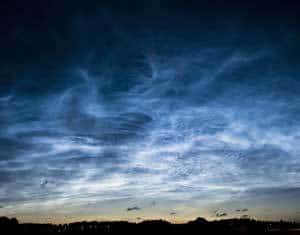
As weather is for all intents and purposes non-existent in the mesosphere, an interesting phenomenon in the form of noctilucent clouds can sometimes be found at altitudes of 80 km (50 miles).
Consisting out of ice crystals, they provide a spectacular view from Earth around 2 hours after sunset. You can find more about this rare phenomenon in this article.
A dynamic feature of the mesosphere is the presence of zonal winds, atmospheric tides, gravity waves, and planetary waves. These waves start in the troposphere and eventually spreads into the mesosphere.
In the mesosphere, the waves/tides become unstable and dissipate, creating momentum in the process. It is this momentum that drives global circulation to a great extent.
Importance Of The Mesosphere
The mesosphere can be seen as another protective layer of the earth's atmosphere. There are two specific "dangers" it helps to protect us from. Both were already mentioned but needed to be emphasized again.
As I already mentioned, meteorites of various sizes burn up in the mesosphere. It is estimated that a meteorite the size of an automobile enters and is vaporized in the mesosphere every year. (Space rocks smaller than 25 meters (82 feet) are vaporized in this layer before it can reach the Earth's surface.)
Now imagine the mesosphere did not protect us from meteorites, and we are hit by a meteor shower, with hundreds of rocks 20 meters in size reaching the earth's surface at supersonic speeds.
I don't need to explain what a city like London or New York will look like after being bombarded with meteorites of this size. (We have all seen disaster movies like "Armageddon" that paints a pretty realistic picture of what can actually happen if it wasn't for the mesosphere.)
The second danger the mesosphere protects us from is the sun's ultraviolet rays. (No, it is not just the ozone layer in the stratosphere.) A combination of ozone and molecular oxygen in the mesosphere protects us from solar radiation with varying wavelengths.
So, as little as we know about the mesosphere, we know enough to realize that it plays a vital role within the structure of the Earth's atmosphere.
As is the case with the troposphere and stratosphere, a small boundary separates the mesosphere from the thermosphere. The mesopause forms the border between the 2 layers.
The relative absence of solar radiation combined with the cooling effect of carbon dioxide in the mesopause makes it the coldest region on earth, with temperatures falling as low as -100° Celsius (-148 ° Fahrenheit).
But we are far from finished. There is yet another layer above the mesosphere that needs to be examined...
The Thermosphere
The thermosphere (sometimes called the Ionosphere) lies between the mesosphere and exosphere. It is only separated from the mesosphere by a thin layer called the mesopause.
From a human perspective, the thermosphere is quite popular and, as a result, one busy place. It plays home to the International Space Station and approximately 800 active satellites.
This off-course this does not include the thousands of pieces of garbage in the form of space debris orbiting the earth in the thermosphere. (Yep, we are not just filling our planet with garbage, but also the space above us, and a very important part of space).
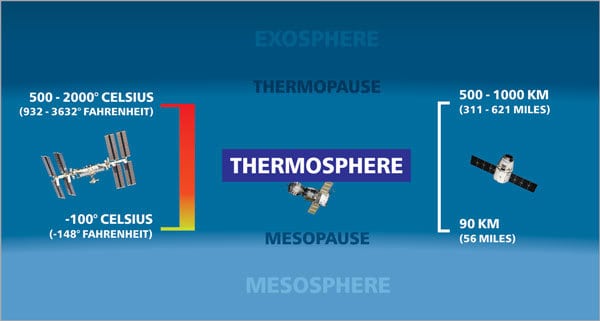
Composition Of The Thermosphere
The air is extremely thin (with almost a zero amount of air density), and gravity almost non-existent in the mesosphere. The properties of air closely resemble that of the vacuum of space as a result.
Since space is seen to start at 100 km (62 miles) above the Earth by many definitions, it is not surprising that the thermosphere is seen as part of space in many circles.
The little air present in the thermosphere mainly consists of helium, atomic nitrogen, and atomic oxygen.
Ions are also created in the thermosphere when ultraviolet radiation causes photoionization of molecules. (This process takes place in the ionosphere, which is spread over the thermospheres and stretches over parts of the mesosphere and exosphere.)
Characteristics Of The Thermosphere
The thermosphere starts at a height of around 90 km (56 miles) and extends up to heights of between 500 - 1000 km (311 to 621 miles). This makes the thermosphere thicker than all the other layers combined.
One of the main characteristics of the thermosphere is the extremely high temperatures that occur within this layer (as the name of the layer would suggest). With temperatures reaching around 2000° Celsius (3632° Fahrenheit), the thermosphere is the hottest of all the layers in the atmosphere by a huge margin.
The temperature is not constant, though. Between day and night, an average difference of 200° Celsius (360° Fahrenheit) can occur. The amount of solar radiation also has a direct influence on the temperature, causing as much as a 500° Celsius (900° Fahrenheit) variation, depending on the amount of radiation.
Ironically, you will not be able to feel these extremely high temperatures. As the air is so thin that it basically resembles a vacuum, there are no particles/atoms in the air to conduct the heat.
As a result of this lack of conduction, you will actually experience cold temperatures. It very often drops to below 0° Celsius (32° Fahrenheit), especially at night.

The spectacular Aurora Borealis (Northern and Southern Lights) takes place in the thermosphere. The Aurora Borealis is a result of charged particles from the sun colliding with gaseous particles in the thermosphere. This causes the colorful light display people in the Northern Hemisphere are so familiar with. (Green is one of the most common colors created.)
Importance Of The Thermosphere
The thermosphere has mainly 3 great benefits, with one being a very beneficial side-effect.
1) Protection Against The Sun's Radiation
It supports and protects all life on earth by absorbing the majority of the sun's X-rays and extreme ultraviolet radiation. A byproduct of the abortion of solar radiation is the creation of the ionosphere.
The ionosphere is a direct result of the vast amount of ions that are formed within the thermosphere. When X-rays and UV radiation collide with gas molecules, some electrons are knocked free to form electrically charged ions. And herein lies the side-benefit...
2) Creation Of The Ionosphere
The great benefit of the ionosphere is its ability to make long-distance radio communication possible.
Before satellite and other forms of wireless communication emerged, radio-waves were the only way to communicate over long distances. As it requires "line-of-sight" to communicate, radio waves are limited by the natural curvature of the earth.
Radio operators then discovered the unique characteristics of the ionosphere. The electrically charged ions act as a giant mirror for radio waves. This simply means radio waves can now travel vast distances by simply bouncing them off the ionosphere.
(There are still limitations, and the use of radio waves has been replaced by digital forms of communication in most cases, but it still remains very important and relevant.)
3) The Ideal Environment For Space Utilization & Exploration
As already mentioned, the thermosphere is home to the ISS (International Space Station) and almost a thousand active low orbit satellites orbiting the earth.
The thermosphere's location and environment make it ideal for us to be able to put objects in a permanent (or semi-permanent) orbit in space.
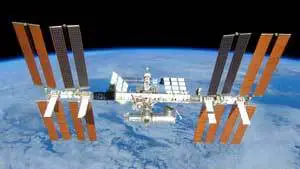
It is high enough for gravity to have very little effect on a spacecraft, yet still close enough to the earth's surface to use less powerful rockets to reach the thermosphere. This makes it much more affordable and economically viable to use the advantages of space.
(In order for a spacecraft to break completely free from earth's atmosphere and travel into outer space, it needs much more powerful rockets that would have been too expensive to make the launch & maintenance of satellites and NASA's Space Shuttle Program economically viable)
In the future, platforms may be built in the thermosphere that will serve as launching pads for deep space exploration. The thermosphere really provides endless possibilities, especially with the increase of companies from the private sector entering the space arena.
Like all the layers below it, the thermosphere is separated from the exosphere above it by a thin layer. The thermopause forms the last layer below which the atmosphere can be seen as active on the insulation received. This is mainly due to the presence of heavier gasses like monatomic oxygen.
Above the thermopause, you will find the atmosphere's fifth and last layer, the point where the atmosphere truly turns into space...
The Exosphere
Taking the prize as the topmost layer of our atmosphere is the exosphere. It is devoid of all substances, except for a small hint of hydrogen and a few atmospheric gaseous particles spread very apart from each other.
It can, for all intents and purposes, be regarded as the layer that has all the properties of space and almost none of those of atmospheric layers.
This layer may not play such a vital role in the earth's atmosphere but is still relevant.
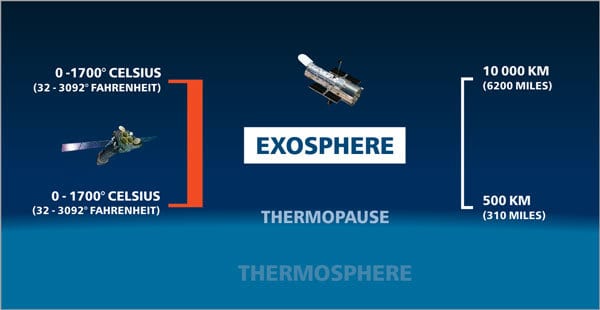
Composition Of The Exosphere
As I already mentioned, the exosphere is almost completely devoid of any substances and atmospheric gasses. This makes the composition of the exosphere resemble that of the vacuum of space very closely. More so than that of any other atmospheric layer.
Mainly due to its inaccessibility and the very little research that could be done as result, very little is known about the precise makeup of the exosphere.
The only elements that can be found in any significant numbers in the exosphere are helium and hydrogen. They are so widely dispersed, however, that their presence is of no real importance or relevance.
Characteristics Of The Exosphere
The exosphere starts just above the thermosphere (and thermopause) at a height of 500 km (310 miles) and extends up to a height of around 10 000 km (6200 miles).
Temperatures are generally very cold and constant. In direct sunlight, it can get very hot and in the shade freezing cold, though. (There are no particles present to conduct heat or cold, which accounts for the extreme temperatures and the generally perceived cold conditions.)
As a result, temperatures vary quite dramatically, from 0° Celsius (32° Fahrenheit) all the way up to 1700° Celsius (3092° Fahrenheit). The biggest temperature difference takes place between daytime and nighttime.
In this vast space, the last traces of elements associated with the atmosphere blends gradually and seamlessly into the vacuum of space.
Many planets and moons (like Mercury, our own Moon, and the Galilean satellites of Jupiter) have no atmosphere, and all have an exosphere starting at surface level.
Since the last remnants of the atmosphere blend so gradually into outer space, no clearly defined upper boundary can be determined.
Importance Of The Exosphere
The exosphere may not play any significant role in supporting and maintaining life on earth, but as I mentioned in the introduction, it is still relevant.
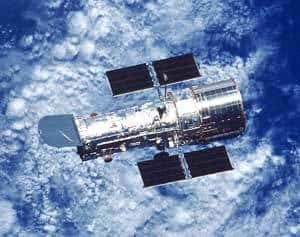
Just like the thermosphere, the exosphere forms the ideal environment for spacecraft to be placed into orbit around the earth.
It has the added advantage of allowing satellites and other objects to be placed in a much higher orbit than communication satellites and the International Space Station placed in lower orbits around the earth.
This higher orbit allows satellites to get a better global view of various activities on earth. The bigger distance from the earth's surface also minimizes the amount of light reflecting off the planet into the atmosphere to cause any kind of interference.
This is why the Hubble Space Telescope and a variety of weather and other scientific satellites can be found orbiting the earth at this altitude. They are also much safer in the exosphere, as there is a lot less "space traffic" to contend with, as well as more room to maneuver in.
Conclusion
Now that one has a very clear understanding of how many layers are present in our atmosphere, each one with its unique properties, you may never look up at the sky in the same way again.
You will also be able to understand why each layer is so unique and important in its own way. The way weather behaves, the height at which airliners fly, and even where we put our satellites... All should become a lot more clear.
I trust this article helped you to better understand the complex but fascinating structure of layers that make up our atmosphere. I am pretty sure quite a few facts might have caught you off-guard but in a pleasant and intriguing way.
Never miss out again when another interesting and helpful article is released and stay updated, while also receiving helpful tips & information by simply following this link .
Until next time, keep your eye on the weather!
